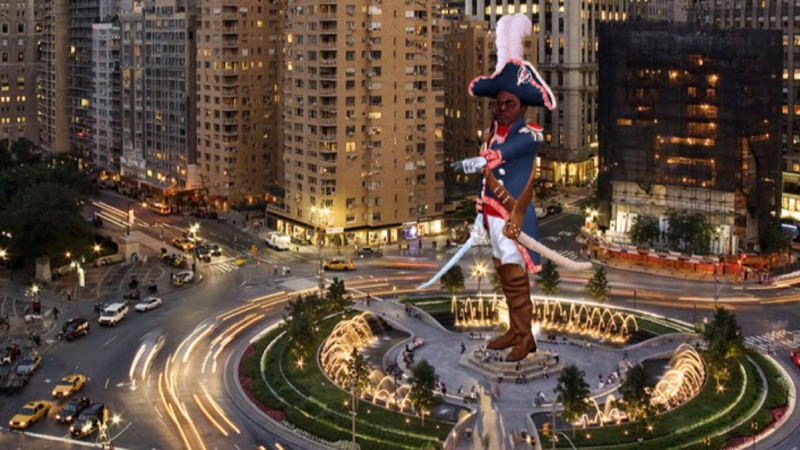This interview is a part of “Memory Loss,” a series co-published with Urban Omnibus.
For better and worse, monuments are obdurate things. Statues are built to last, stubbornly reminding us of conflicted legacies, enduring injustices and, occasionally, the power of truth and reconciliation. Yet their very solidity implies an imbalance of power in how history is written. Statues are neither easily created nor removed—though with shared strength and conviction, they can sometimes be toppled.
Movers and Shakers NYC, an artist/activist collective-turned-social enterprise, have adopted a different strategy in the struggle against the persistent inequities cast in stone and metal across the United States. Emerging in 2017 to challenge the vast racial and gender disparities of New York City’s statues—which overwhelmingly represent white, male historical figures—Movers and Shakers wields immersive technologies to rewrite and redistribute the monument as we know it. In late February 2020, the company launched the first iteration of their Monuments Project: Kinfolk, an augmented reality mobile app that allows users to “install” interactive digital models in any location with a horizontal surface, from the dining room table to the sidewalk. Starting with seven icons of Black history—four of which are sponsored by a new Netflix documentary series—Movers and Shakers hopes to grow the Monuments Project into a sprawling, collaboratively-built archive of augmented artifacts to underrepresented histories, both individual and collective.
Where they hope their app will be used the most, however, is the classroom. Featuring text, images, links to additional resources, and even themed playlists bundled with, and tailored to, each monument, Kinfolk is designed with education in mind (while its cutting-edge format finds a natural audience in a new generation of learners). I spoke with Movers and Shakers co-founders Glenn Cantave and idris brewster about their project’s ambitious, nationwide roll-out, and about the promise and challenges of using technology to carve out new, everyday spaces for pedagogy and protest in an uneven landscape of public memory.
–Joshua McWhirter for Guernica and Urban Omnibus
Joshua McWhirter: How did Movers and Shakers get started?
Glenn Cantave: We started off doing a campaign to advocate for the removal of the statue of Christopher Columbus at Columbus Circle, and by hosting teach-ins and performance art demonstrations to add pressure on the mayor to remove not only that statue, but other racist statues throughout New York City, and to uplift under-told stories in monument form.
At the end of the day, the mayor refused to remove the statue of Columbus. And so we saw an opportunity with augmented reality to place statues of whoever, wherever we want—with or without permission. The genesis of the Monuments Project, manifested in the Kinfolk AR app, was this idea that we can create our own catalogue of monuments to women and people of color, and not only place them in New York City, but nationwide.
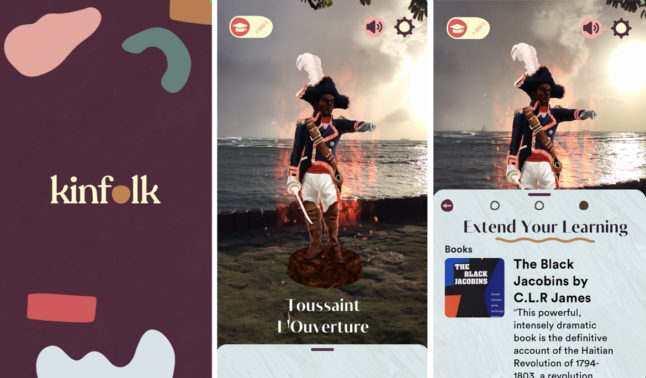
Joshua McWhirter: How did augmented reality (AR) become the medium of choice for the Monuments Project?
idris brewster: While we were campaigning for the removal of the Columbus statue, we were experimenting with a lot of different kinds of immersive media, and were actually initially interested in virtual reality. We made a 360-degree installation—really, we tried to put our illustrations into headsets.
What we realized, though, was that there’s something special about augmented reality, in the sense that it connects the digital and the physical worlds, and it is a good way to start conversations among communities. AR is the most accessible immersive media technology, and when we were thinking about who we’re building this content for, and why we’re building it: It’s for the communities of color. With that in mind, we just wanted to be able to get these new and cool immersive stories out to as many people as possible.
Augmented reality allowed us to place monuments wherever. It could be in public space. It could be at your home. What we realized later is that it could even be in your classroom. And when you put it in the classroom, that brings spatialized experiences to an education format, which is something missing from the way that our kids are learning today.
Joshua McWhirter: What led you both to focus this work, at least initially, on reaching youth?
idris brewster: All throughout, we’ve been focused on monuments—on the visual representation that our city was showing us and the disparity there. But in order to attack the problem, just placing different monuments to adjust the parity of our representation in the city is not doing enough. With each teach-in and demonstration of the app that we were doing, the underlying goal was always education. We saw that there was a gap in the amount of learning in general that people were getting from our monuments, from our history books, from our education system. That was always the focus, and later in the project’s development, we started focusing on kids.
When we moved into the education space, what we found was that our competition was the McGraw Hill textbook. And after doing more interviews with students, we were seeing that they didn’t want to read like that. When they interacted with our application, it really brought them into the mindset as if they were playing video games at home with their friends—as if they were on TikTok. They were more receptive to taking this information in because they were used to engaging with it like that.
So while people that are older might have trouble interacting with an AR interface, students were easily picking it up. Even kids around the age of five can intuitively figure it out after a few uses.
Glenn Cantave: An emerging technology like AR is still an opt-in technology. And the biggest challenge right now is, number one, to get people to understand what it is, and then, number two, to get people to download an app. If you apply what we’re doing to a school context, and you make the content of the Kinfolk AR app mandatory homework, then all of a sudden you’re expanding our audience to what could be millions of kids. And then we’re changing the minds of the youth.
Joshua McWhirter: How much work actually goes into building out this catalogue of augmented reality monuments?
idris brewster: This is still cutting-edge technology. There’s a lot of stuff that goes into it. What’s really important for us is making sure that the experience is as high-quality and vivid and beautiful as possible. Each of these monuments takes 200-plus hours to make.
While accessibility seems like something that people take for granted, it’s something that we really strive for. Part of building with this technology is understanding the limitations. In the beginning, we wanted to do a lot of geolocated monuments in public spaces. We wanted to make it so that you could bring the models to wherever you were. But it was only Glenn and I, and Micah Milner, our chief operating officer; we had the naïve idea that we could just build it out ourselves.
We could build little prototypes, but to get something to the level of Pokémon Go or a consumer-level app where everyone can access it, it takes a lot. And so those three years that we spent from the beginning of the project to now involved a lot of experimenting, a lot of convincing people that this technology and this use case that we have is really worth it to push forward. And even now when we’re seeing the app finally come to life, there’s just a lot of stuff in place. We have ten developers on the team. We have a pedagogy team of seven people. There’s a lot of moving parts going into this.
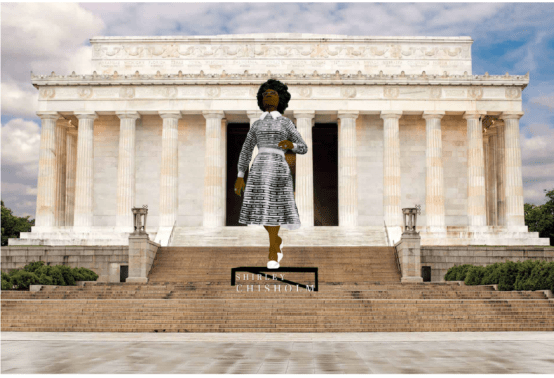
Joshua McWhirter: What does the long-term rollout of this project look like, as you’re able to foresee it?
Glenn Cantave: With the official launch of the Kinfolk AR app, there are seven AR monuments, each one with corresponding pedagogy piece that students, teachers, and parents can engage with on their own or at home. Some are New York heroes. Others aren’t. For many, it may be the first time that you hear these stories, which is the point of what we’re doing. We have Congresswoman Shirley Chisolm, Audre Lorde, Toussaint Louverture, Ida B. Wells, Bayard Rustin, Pauli Murray, and Frederick Douglass. The main thing for us is that the launch is really an open invitation for other artists and historians and curators to come together and join us in this project. Because right now we know that we have a dynamic and entertaining way to unearth historically excluded histories; but at the same time we’re not experts in all things pedagogy. So we’re calling for people to come together to contribute to this project.
Intermittently, as we’re getting rolling on sets on monuments in different places, we’re approaching different city councils to understand if there’s an interest for us to develop AR monuments of their local heroes and add them to the catalogue over time.
Simultaneously, we’re building out a research department to host focus groups with teachers and school administrators and various educators to understand how we can best adapt our app as a supplement for education in the classroom specifically. Because at the end of the day, our goal is for this catalogue of information and this retelling of history to really be anchored in the classroom. And we want every kid in all 50 states to be able to interact with this content.
idris brewster: I think there’s a lot of worries that come with releasing a somewhat experimental technology so widely. It is still a work in progress. And we’re proud of that work in progress, but we want to get all the feedback from the important people that we’re building this for in order to get the direction that we’re moving in completely correct. What’s important for us is to show the product and where we’re at with this project, and to lean on the community that we’re building it for to guide us in terms of how we’re going to move this work forward.
We could make a bunch of assumptions on our own in terms of how we think this stuff should be used. But what’s important to us is the voices of the communities that we’re building this for. The next six months are really important for us to figure out the long-term direction for this app.
Joshua McWhirter: At this point in the development of the project, what does collaboration with historians and educators look like?
Glenn Cantave: There are a lot of hats that we have to wear. And we’d like to give those hats to experts. While we’ve done a lot of research ourselves, we are not historians. And we really want to bring in Black and brown historians to help us see what we cannot see, to help us learn what we don’t know. Selfishly speaking, as well, this is a way for us to learn what we never got to as kids ourselves. The first step is just understanding who needs to be highlighted, and looking at history through different lenses.
From there, it’s about doing the groundwork of gathering primary source and secondary source info that we’ve found to be locked behind paywalls and decentralized in archives throughout the country. That, in itself, is a function of historical exclusion. We need experts to do the legwork to compile this data and put it all in one place. And the Kinfolk AR app is a place for that to live. From art to video to audio to text, we’re looking for different formats of placing that all together.
We’re also looking to work with historical societies to understand what it means to zoom out of portraying monuments as just an individual person. What does it mean to portray an event? What does it mean to portray a historical site, and to accurately portray a nuanced retelling of history through stories that are outside of just individuals?
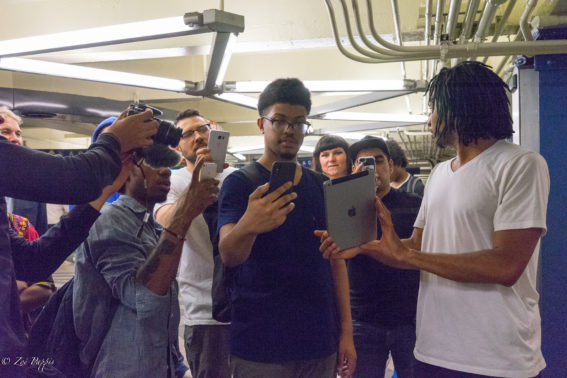
Joshua McWhirter: Between the pandemic and last summer’s uprisings, how have the events of the past year impacted the themes or scope of the project?
Glenn Cantave: The crazy times that we’re in have impacted our project profoundly. Obviously, it’s not safe to go outside and gather people in public spaces in ways that we normally do. And so that has really shifted our focus to ensuring that we can provide our monuments for people who are learning remotely, meaning that whatever the catalogue ends up being in the long term, whether it’s thousands of monuments, tens of thousands, they will all be in your pocket. The pandemic has really accelerated our push towards ensuring that we’re backing everything up with proper pedagogy, and that we’re launching for schools in the long term.
But at the same time, Black people have endured the pandemic of racism for more than 400 years. And before this past summer, there were tons of charged and loaded conversations that we did not know how to have as a country. The uprisings that happened in the summer really pulled the genie out of the bottle in a way where you can’t put it back in.
A lot of conversations that Idris and Micah and myself have had over the past few years in the development of this product are now being had on a national basis. So, the good news for us is that there’s more awareness of the fact that the way that we tell our history is problematic. The process of dehumanization of Black and brown folks is a generational issue that is still yet to be solved. People are looking for a way to reconcile with the past, and to understand how to move forward. And we believe that the Kinfolk AR app is an appropriate way to engage not only the youth, but the general public, both in a classroom context and in a post-COVID time in public spaces through reinventing what a teach-in looks like—by taking the labor out of learning, by basically educating folks, while at the same time making sure that people are having fun and are captivated by a new way of storytelling.
That’s not to say that there is no potential for impact with the broader public, but rather we have more of a guaranteed sense of impact with measurable learning outcomes that we can push for in the educational context, while simultaneously pushing in the public spaces as well. And so that was huge for us.
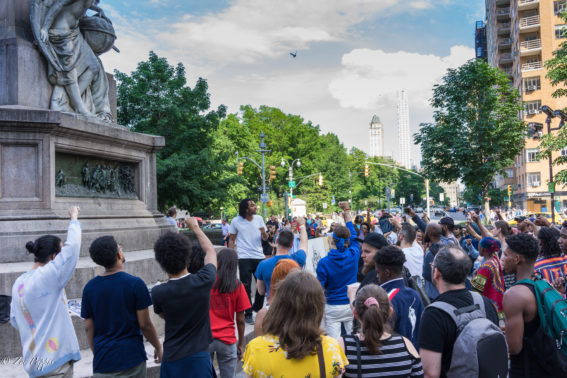
Joshua McWhirter: Seeing as the project emerged out of public protest, do you have any sense of how it might feed into activism in the future?
Glenn Cantave: Right now, we’re focused on the schools and the educational aspect. But at the end of the day, you can draw a line between any social issue and a moment in history. All of it stems from a seed. Whether it’s unsympathetic immigration policy tying to colonialism, or police brutality being tied to dehumanization, or mass incarceration being tied to slavery, all of it has a context in history.
And history rhymes a lot of the time. It’s very clear that if we don’t get it right the first time and don’t understand as a nation how to collectively move forward, that we’re doomed to repeat it. So, there’s definitely an opportunity for us to work with organizations that have boots on the ground to provide historical context to issues that mirror present day. We’re definitely looking forward to exploring what that looks like with different groups; but right now, we have to get the product right first.

